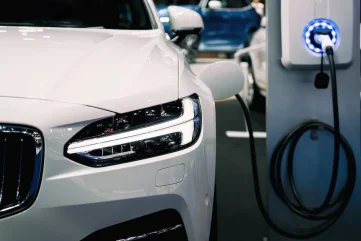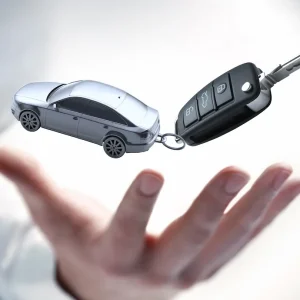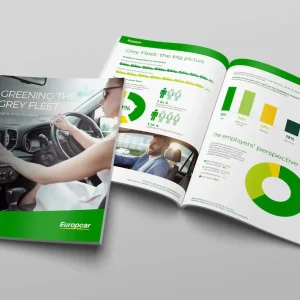
After returning from travels abroad, Emma Turness found herself working at a Hertz rental branch. However, it wasn’t long before she transitioned into the fleet admin department of a fleet management company – a move that sparked her enduring enthusiasm for the fleet industry.
Turness’s career trajectory took a significant leap when she joined Countrywide nearly two decades ago as an assistant fleet manager. Her dedication and skill led to her promotion to fleet manager a decade later. The acquisition of Countrywide by Connells Group in March 2021 further expanded her role, culminating in her current position as group fleet manager.
“Once you’re in the fleet industry, you’re hooked,” Turness shares. “It’s still largely a male-dominated field, but I’m thrilled to see more women entering the industry – and I can see why. I love it.”
Initially, Turness’s role was centred around operational tasks. However, her recent promotion to group fleet manager has broadened her responsibilities, now encompassing both strategic and operational oversight of the fleet, including procurement, maintenance, compliance, and resource optimisation, all while maintaining a keen focus on cost efficiency.
Streamlining operations
Upon stepping into her new role in 2023 at the Milton Keynes branch, Turness was immediately tasked with a pivotal challenge: implementing a comprehensive new fleet strategy. Central to this strategy was the overhaul of the vehicle policy, which aimed to align the fleet more closely with the company’s long-term goals.
The Connells Group fleet, comprising approximately 2,400 cars and eight vans, serves a dual purpose. It includes vehicles dedicated to business functions – such as those assigned to branch staff including negotiators, managers, and surveyors – as well as perk vehicles provided to managers with specific mobility needs.
A significant aspect of Turness’s policy review involved streamlining the selection of vehicle manufacturers. Whereas the previous policy offered a broad range of brands for perk drivers, the revised strategy narrowed the focus to four or five key partners. “This decision was driven by the need to align with the right partners based on current and future product offerings, and to secure enhanced commercial terms by concentrating our requirements,” Turness explains. As a result, the group’s primary automotive partners now include BMW, Audi, VW, Mercedes, and Stellantis.
At the London branch of John D. Wood, letting and estate agent staff have access to more premium vehicles, reflecting the competitive nature of the estate agency market. “When they’re selling million-pound homes, it’s important they arrive in a car that conveys the right level of prestige,” explains Turness.
The fleet’s structure is diverse, incorporating various funding options and lease types, ranging from monthly flexible rentals to four-year contract hire agreements or even owned assets. “This structure provides the flexibility to adjust the fleet size as needed,” Turness notes.
Given that the company is owned by Skipton, one of the largest building societies in the country, Turness says they meticulously evaluate the best funding method before each order, which results in a blended approach. “Additionally, we sometimes opt for a capitalised lease instead of the traditional one-plus model, as it often proves to be the most financially viable leasing option,” she adds.
The standard lease profile for Connells Group’s fleet vehicles is 48 months and 48,000 miles. However, Turness emphasises that this is not a rigid framework. “We sometimes deviate from this standard for shorter-term, flexible vehicles to meet specific business needs.”
For owned vehicles, the group typically extends their use if the mileage remains low and maintenance costs are minimal. “Additionally, we carefully consider the performance of the second-hand market to ensure we maximise the asset’s return upon disposal,” Turness says.
A phased transition
While some divisions within the Connells Group have already completed their transition to EVs and established a robust charging infrastructure, the broader fleet is currently in the midst of a phased transition. The first to embrace this shift were the London and perk fleets, both of which have begun integrating electric vehicles. The remainder of the fleet is gradually moving towards a combination of plug-in hybrids and EVs.
The initial focus of the newly implemented policy was on ensuring that all vehicles in the fleet met the ULEZ standards. This marked a significant pivot towards sustainability, particularly for non-essential fleet users, who are now exclusively offered ULEVs.
“That’s what I’ve eaten, lived, and breathed,” Turness reflects, underscoring her commitment to revitalising the fleet policy. “It hasn’t been an easy task, but I’m now nearing the finish line.”
In 2023, the London-based arm of Connells, John D Wood & Co., made a bold move by converting their entire fleet of more than 50 vehicles to electric. This initiative significantly increased the number of vehicles emitting less than 30 grams of CO2 per mile, rising from 3% in 2022 to 14% by 2024.
Currently, 7% of Connells Group’s entire fleet consists of electric vehicles, with an additional 16% being plug-in hybrids. Turness anticipates these numbers will rise once the existing order backlog is cleared this month.
The transition to a fully electric fleet elsewhere in the country, including Milton Keynes, will have to be more gradual, given the challenges of operating. “In regions like Wales, the infrastructure for EVs is still lacking, making it impractical to switch entirely to electric vehicles right now,” Turness explains.
Understanding and accommodating staff needs is also crucial, especially for younger negotiators who might live in flats without convenient access to charging facilities. “The plan is to maintain a mix of hybrids and EVs, ensuring that each vehicle grade includes an electric option,” notes Turness. “This approach allows employees the flexibility to choose when they’re ready to make the transition to electric.”
Even as an EV driver herself, Turness believes that for now, having a home charger and a second vehicle in the family is still necessary. “We’re not quite at the point where an EV can be the sole car for everyone,” she says. “However, we’re making significant progress – some models now offer a range of nearly 460 miles. In a few years, when that kind of range becomes more standard, the need for a second car will likely disappear.”
Reflecting on the feedback from agents regarding the switch to EVs for those agents who have made the change, Turness exclaims, “I think it’s fair to say that they love the new vehicles. These EVs replaced older models, and the technological advancements are substantial.”
She further explains that drivers were educated about the policy before making their choices, ensuring they understood the financial implications. The policy also encouraged them to consider practical factors like home and public charging options, as well as the vehicle’s suitability for personal use, such as during holidays. This approach provided flexibility, allowing drivers to ‘swap’ their cars to better suit their needs.
Measuring and tracking emissions is a crucial aspect of the fleet’s transition, particularly for the group’s Environmental, Social, and Governance (ESG) team. “Many of our locations are on high streets, making office charging impractical in most cases, so the transition to EVs has been gradual,” notes Turness.
Data collection plays a pivotal role in shaping future plans to further electrify the fleet. For example, the group has engaged Catalyst to independently verify the accuracy, completeness, and consistency of energy usage and CO2 emissions data for company vehicles and business travel in employee-owned vehicles.
Looking ahead, Turness outlines the fleet’s ongoing efforts to achieve Net Zero emissions by 2045, a goal where the fleet is a top priority. She and her team are continually reviewing policies to reduce CO2 emissions, which currently amount to 1,660 tCO2e over seven million miles driven in 2023.
As the journey towards sustainability progresses, Turness emphasises that the group is committed to refining its strategy. “We recognise that achieving our net zero targets involves various factors and uncertainties beyond our control, including policies set by governments, policymakers, and suppliers,” she explains.
A future for hydrogen
Turness envisions a promising future for hydrogen as an alternative fuel source, despite its current slow development. “Although the advancement of hydrogen technology has been slower than anticipated, and building the necessary infrastructure will be a significant undertaking, the undeniable cleanliness of its exhaust emissions makes it a compelling option,” she explains.
In the meantime, Turness views EVs a crucial stepping stone in the transition towards more sustainable transportation. “We knew from the outset that this transition wouldn’t be an overnight solution, but the recent increase in superchargers has certainly made longer journeys more feasible,” she notes. “While there are still regions across the country that require attention, we’re seeing noticeable progress every day.”
However, Turness acknowledges the challenges that come with the current state of EV charging infrastructure, particularly the cost. “The pricing at these charging stations needs to be reassessed,” she states. “At nearly £1 per kilowatt-hour, relying on public chargers without the advantage of a cheaper overnight home charging tariff makes driving an EV more expensive than it should be.”
For the majority of Connells Group employees who have opted for an EV, the choice was made through a user-chooser program, which allowed them to research and select their preferred options in advance. “For most business trips, the return journey can be completed on a single charge,” Turness explains. “Managing the small percentage of trips that require additional charging simply involves a shift in behaviour and more thoughtful journey planning.”
To support this transition, the Connells Group has begun installing chargers at its head office sites and at several branches where a full transition to EVs is already underway. Currently, about 40% of the branches have EV chargers installed, and Turness is optimistic about increasing this number as more locations become suitable for the infrastructure.
“Working closely with our ESG team, I anticipate that at least 75% of our fleet will be EVs in the near future,” she says. “This figure could rise even higher depending on the uptake in the next round of vehicle orders. I also expect to see more drivers opting for salary exchange, particularly those on a cash allowance who aren’t entitled to choose a company car.”
When asked about her daily life as a fleet manager, Turness reflects on the constant challenges the role presents. “No two days are the same,” she shares. “We have to be ready to react and deal with whatever comes our way to ensure we continue to provide reliable mobility for our employees.”
Turness is excited to continue to learn about fleet in her new role as group fleet manager.
“I’m always learning and while I was more behind the scenes before, I am now the decision maker and I can make change. It has been a great challenge so far, and I’m enjoying planning for the future.”





